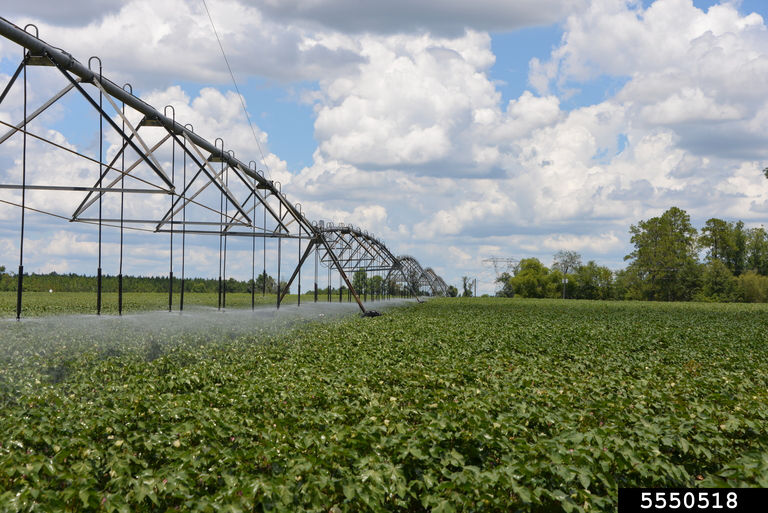3 MIN READ
When to Terminate Irrigation in Cotton
August 15, 2023
When to Terminate Irrigation in Cotton
- Deciding when to terminate irrigation can affect yield potential and efficiencies in cotton production.
- Irrigation termination decisions should be made on a field-by-field basis and should consider plant developmental stage, soil type, soil moisture status, the type of irrigation system used, geography, boll load, and crop health.
- Applying too much water late in the season may lead to problems such as unnecessary vegetative growth, delays in boll maturity, and reduced defoliant efficacy.

General Irrigation Termination Guidelines
For cotton, proper irrigation termination relies on observing the plants’ developmental stage, with some recommendations coordinating plant developmental stage with accumulated heat units. The water holding capacity of the soil (soil type) and the type of irrigation system used can also impact when irrigation should be terminated. In some cases, irrigation may be terminated earlier on soils with a high water-holding capacity, because sufficient water may remain in the soil to bring the crop through maturity.
Generally, furrow irrigation systems deliver two to three inches of water per acre with each application, and furrow irrigation systems are more likely to fill the soil to field capacity than are pivot or drip irrigation systems. However, the amount of water applied by a furrow irrigation system may be substantially less depending on well capacity. Irrigation may also need to be terminated later for fields with pivot or drip irrigation, as less water is applied per application.1
Termination Recommendations
Boll developmental stage. Peak water use for cotton occurs during boll development and begins to decline prior to first open boll. For furrow irrigation, terminating irrigation is recommended when cotton reaches first cracked boll. If termination of furrow irrigation occurs earlier, the uppermost bolls may have inconsistent development. Irrigating beyond first cracked boll can lead to boll rot and hardlock due to increased moisture in the canopy.1,2
Pivot irrigation can be terminated about 10 days after first cracked boll1 or at 10% open boll.2 Applying water from an overhead system after bolls have opened can lead to boll rot and hardlock. However, lack of adequate water can be more damaging, potentially leading to reduced weight and fiber quality in the uppermost bolls which can translate into yield loss.1
Heat unit accumulation after cutout. Another recommendation is to terminate furrow irrigation when heat units have accumulated to a specified amount after cutout. Cutout occurs when there are five nodes above the uppermost first position white flower (NAWF = 5). Generally, 350 to 600 accumulated heat units are needed before irrigation termination, depending on the geography, soil type, irrigation system, boll load, and when irrigation was initiated.3 For example, irrigation can be terminated at 350 to 400 DD60s after cutout in fields with a deep root system and adequate moisture in the top two feet of soil. In fields with shallow roots and dry soil, irrigation termination can be delayed until 600 DD60s after cutout.3,4
Late-Season Irrigation Precautions
Applying a small amount of additional moisture after the recommended termination period may help small bolls mature, but applying too much water may cause problems such as unnecessary vegetative growth, delays in boll maturity, and reduced defoliant efficacy. Too much moisture can also increase pest pressure and the potential for boll rot, especially for fields with overhead irrigation systems.3 Additionally, the added expense of late-season irrigation may not be provide adequate benefits to the final yield.1 Terminating too early can lead to reduction in yield and reduced fiber quality, with lower micronaire and uniformity.3
These termination guidelines are general. Irrigation termination decisions should be made on a field-by-field basis considering plant developmental stage, soil type, soil moisture status, the type of irrigation system used, geography, boll load, and crop health.
Sources
1 Dodds, D. 2018. Cotton irrigation termination. Mississippi Crop Situation. Mississippi State University Extension. https://www.mississippi-crops.com/2018/08/11/cotton-irrigation-termination-3/.
2 Hall, D., Cloud, C., and Porter, W. 2020. Cotton irrigation termination. Plow Points. University of Georgia Cooperative Extension. https://site.extension.uga.edu/plowpoints/2020/09/cotton-irrigation-termination/.
3 Taghvaeian, S., Byrd, S., and Goodson, J. 2021. Oklahoma cotton: When to terminate irrigation. AgFax. https://www.agfax.com/2021/08/24/oklahoma-cotton-when-to-terminate-irrigation/.
4 Robertson, B. and Hamilton, M. 2021. Know when to terminate irrigation for Arkansas cotton. Cotton Farming. https://www.cottonfarming.com/breakingnews/know-when-to-terminate-irrigation-for-arkansas-cotton/.
1421_94879